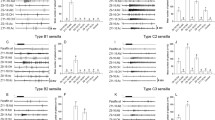Abstract
The flight-tunnel response of male Z-strain European corn borer moths (ECB), Ostrinia nubilalis, from a population in New York State (USA), was significantly antagonized by addition of 1% (Z)-11-hexadecanal (Z11-16:Ald) to their sex pheromone (a 97:3 mix of (Z)- and (E)-11-tetradecenyl acetate [Z/E11-14:OAc]). The level of antagonism was equivalent to that observed for the previously identified ECB antagonist, (Z)-9-tetradecenyl acetate (Z9-14:OAc), and supports a recent report showing that Z11-16:Ald, a minor pheromone component of the Noctuid moth, Sesamia nonagrioides, caused antagonism of ECB pheromone communication in sympatric populations in the Iberian Peninsula. Single-sensillum recordings from ECB antennae, which included cross-adaptation experiments, showed that the same olfactory receptor neuron processing Z9-14:OAc inputs was responsible for detecting Z11-16:Ald, and that this neuron was not responsive to two other aldehydes, (Z)-9-tetradecanal (Z9-14:Ald) and (Z)-9-hexadecanal (Z9-16:Ald), found in other moth sex pheromones. Our results show that the antagonism is not confined to one geographic region, is specific for Z11-16:Ald, and that antagonist pathways might have the potential for processing a number of structurally similar compounds.





Similar content being viewed by others
References
Baker, T. C. 1989. Sex pheromone communication in the Lepidoptera: new research progress. Experientia 45:248-262.
Baker, T. C., Ocheing S., Cossé A. A., Lee, S. G., Todd, J. L., Quero, C., and Vickers, N. J. 2004. A comparison of responses from olfactory receptor neurons of Heliothis subflexa and Heliothis virescens to components of their sex pheromone. J. Comp. Physiol. A 190:155–165.
Cardé, R. T. and Haynes, K. F. 2004. Structure of the pheromone communication channel in moths, pp. 283–332, in R. T. Cardé and J. G. Millar (eds). Advances in Insect Chemical Ecology. Cambridge University Press, Cambridge, UK.
Cossé, A. A., Campbell, M. G., Glover, T. J., Linn, C. E., Todd, J. L., Baker, T. C., and Roelofs, W. L. 1995. Pheromone behavioral responses in unusual male European corn borer hybrid progeny not correlated to electrophysiological phenotypes of their pheromone-specific antennal neurons. Experientia 51:809–816.
Domingue, M. J., Roelofs, W. L., Linn, C. E., and Baker, T. C. 2006. Effects of egg-to-adult development time and adult age on olfactory neuron response to semiochemicals in European corn borers. J. Insect Physiol. 52:975–983.
Eizaguirre, M., Sans, A., López, C., and Albajes, R. 2002. Effects of mating disruption against the Mediterranean corn borer, Sesamia nonagroides, on the European corn borer, Ostrinia nubilalis. IOBC/WPRS Bull. 25: 59–68.
Gemeno, C., Sans, A., López, C., Albajes, R., and Eizaguirre, M. 2006. Pheromone antagonism in the European corn borer moth Ostrinia nubilalis. J. Chem. Ecol. 32:1071–1084.
Glover, T. J., Perez, N., and Roelofs, W. L. 1989. Comparative analysis of sex-pheromone-response antagonists in three races of European corn borer. J. Chem. Ecol. 15:863–873.
Goldman, A. L., van der Gies van Naters, W., Lessing, D., Warr, C. G., and Carlson, J. R. 2005. Coexpression of two functional odor receptors in one neuron. Neuron 45:661–668.
Hansson, B. S., Löfstedt, C., and Roelofs, W. L. 1987. Inheritance of olfactory response to sex pheromone components in Ostrinia nubilalis. Naturwissenschaften 74:497–499.
Ishikawa, Y., Takanashi, T., Kim, C-G, Hoshizaki, S., Tatsuki, S., and Huang, Y. 1999. Ostrinia spp. In Japan: their host plants and sex pheromones. Entomol. Exp. Appl. 91:237–244.
Kaissling, K.-E. 1974. Sensory transduction in insect olfactory receptors, pp. 243–273, in L. Jaenicke (ed.). Biochemistry of Sensory Functions, Springer, Berlin.
Kim, C., Hoshizaki, S., Huang, Y., Tatsuki, S., and Ishikawa, Y. 1999. Usefulness of mitochondrial COII gene sequences in examining phylogenetic relationships in the Asian corn borer, Ostrinia furnacalis, and allied species (Lepidoptera: Pyralidae). Appl. Entomol. Zool. 34:405–412.
Lee, S-G., Carlsson, M. A., Hansson, B. S., Todd, J. L., and Baker, T. C. 2006. Antennal lobe projection destinations of Helicoverpa zea male olfactory receptor neurons responsive to heliothine pheromone components. J. Comp. Physiol. A. 192:351–363.
Linn, C. E. Jr. and Roelofs, W. L. 1995. Pheromone communication in the moths and its role in the speciation process, pp. 263–300, in D. Lambert and H. Spencer (eds.). Speciation and the Recognition Concept: Theory and Application. Johns Hopkins University Press, Baltimore, MD.
Löfstedt, C. 1993. Moth pheromone genetics and evolution. Philos. Trans. R. Soc. Lond. B. 340:167–177.
Ochieng, S. A., Park, K. C., and Baker, T. C. 2002. Host plant volatiles synergize responses of sex pheromone-specific olfactory receptor neurons in male Helicoverpa zea. J. Comp. Physiol. A. 188:325–333.
Roelofs, W. L., Du, J. W., Tang, X. H, Robbins, P. S., and Eckenrode, C. J. 1985. Three European corn borer populations in New York based on sex pheromones and voltinism. J. Chem. Ecol. 11:829–836.
Roelofs, W. L., Glover, T., Tang, X. H., Sreng, I., Robbins, P., Eckenrode, C. J., Löfstedt, C., Hansson, B. S., and Bengston, B. O. 1987. Sex pheromone production and perception in European corn borer moths is determined by both autosomal and sex-linked genes. Proc. Natl. Acad. Sci. U S A 84:7585–7589.
van der Pers, J. N. C. and den Otter, C. J. 1978. Single cell responses from olfactory receptors of small ermine moths to sex-attractants. J. Insect Physiol. 24:337–343.
Vickers, N. J., Christensen, T. J., and Hildebrand, J. G. 1998. Combinatorial odor discrimination in the brain: attractive and antagonistic odor blends are represented in distinct combinations of uniquely identifiable glomeruli. J. Comp. Neurol. 400:35–56.
Acknowledgment
We thank Kathy Poole for her help in maintaining the ECB colonies. The project was funded by NSF IBN #034340.
Author information
Authors and Affiliations
Corresponding author
Rights and permissions
About this article
Cite this article
Linn, C.E., Domingue, M.J., Musto, C.J. et al. Support for (Z)-11-Hexadecanal as a Pheromone Antagonist in Ostrinia nubilalis: Flight Tunnel and Single Sensillum Studies with a New York Population. J Chem Ecol 33, 909–921 (2007). https://doi.org/10.1007/s10886-007-9268-3
Received:
Accepted:
Published:
Issue Date:
DOI: https://doi.org/10.1007/s10886-007-9268-3




